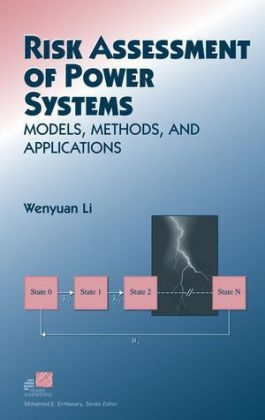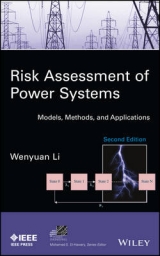
Risk Assessment for Power Systems
John Wiley & Sons Inc (Verlag)
978-0-471-63168-2 (ISBN)
- Titel erscheint in neuer Auflage
- Artikel merken
Power system risk assessment is becoming an important and mandatory task in planning, operation, maintenance, and asset management of utilities, particularly under the deregulation environment. This book will provide readers with the tools to solve practical problems using appropriate risk assessment techniques. Both analytical and Monte Carlo evaluation methods are discussed with an emphasis on applied techniques and actual considerations in generation, transmission, substation, and distribution systems.
WENYUAN LI, PhD is a specialist engineer at British Columbia Transmission Corporation in Canada. Dr. Li has been recognized as an "Outstanding Engineer" by IEEE Canada. In 2002, he received an IEEE Fellow award for contributions in power system reliability theory, calculation methods and algorithms, and industry applications.
Preface. 1 Introduction. 1.1 Risk in Power Systems. 1.2 Basic Concepts of Power System Risk Assessment. 1.3 Outline of the Book. 2 Outage Models of System Components. 2.1 Introduction. 2.2 Models of Independent Outages. 2.3 Models of Dependent Outages. 2.4 Conclusions. 3 Parameter Estimation in Outage Models. 3.1 Introduction. 3.2 Point Estimation of Mean and Variance of Failure Data. 3.3 Interval Estimation of Mean and Variance of Failure Data. 3.4 Estimating Failure Frequency of Individual Components. 3.5 Estimating Probability from a Binomial Distribution. 3.6 Experimental Distribution of Failure Data and Its Test. 3.7 Estimating Parameters in Aging Failure Models. 3.8 Conclusions. 4 Elements of Risk Evaluation Methods. 4.1 Introduction. 4.2 Methods for Simple Systems. 4.3 Methods for Complex Systems. 4.4. Conclusions. 5 Risk Evaluation Techniques for Power Systems. 5.1 Introduction. 5.2 Techniques Used in Generation--Demand Systems. 5.3 Techniques Used in Radial Distribution Systems. 5.4 Techniques Used in Substation Configurations. 5.5 Techniques Used in Composite Generation and Transmission Systems. 5.6 Conclusions. 6 Application of Risk Evaluation to Transmission Development Planning. 6.1 Introduction. 6.2 Concept of Probabilistic Planning. 6.3 Risk Evaluation Approach. 6.4 Example 1: Selecting the Lowest--Cost Planning Alternative. 6.5 Example 2: Applying Different Planning Criteria. 6.6 Conclusions. 7 Application of Risk Evaluation to Transmission Operation Planning. 7.1 Introduction. 7.2 Concept of Risk Evaluation in Operation Planning. 7.3 Risk Evaluation Method. 7.4 Example 1: Determining the Lowest--Risk Operation Mode. 7.5 Example 2: A Simple Case by Hand Calculations. 7.6 Conclusions. 8 Application of Risk Evaluation to Generation Source Planning. 8.1 Introduction. 8.2 Procedure for Reliability Planning. 8.3 Simulation of Generation and Risk Costs. 8.4 Example 1: Selecting Location and Size of Cogenerators. 8.5 Example 2: Making a Decision to Retire a Local Generation Plant. 8.6 Conclusions. 9 Selection of Substation Configurations. 9.1 Introduction. 9.2 Load Curtailment Model. 9.3 Risk Evaluation Approach. 9.4 Example 1: Selecting Substation Configuration. 9.5 Example 2: Selecting Transmission Line Arrangement Associated with Substations. 9.6 Conclusions. 10 Reliability--Centered Maintenance. 10.1 Introduction. 10.2 Basic Tasks in RCM. 10.3 Example 1: Transmission Maintenance Scheduling. 10.4 Example 2: Workforce Planning in Maintenance. 10.5 Example 3: A Simple Case Performed by Hand Calculations. 10.6 Conclusions. 11 Probabilistic Spare--Equipment Analysis. 11.1 Introduction. 11.2 Spare--Equipment Analysis Based on Reliability Criteria. 11.3 Spare--Equipment Analysis Using the Probabilistic Cost Method. 11.4 Example 1: Determining Number and Timing of Spare Transformers. 11.5 Example 2: Determining Redundancy Level of 500 kV Reactors. 11.6 Conclusions. 12 Reliability--Based Transmission--Service Pricing. 12.1 Introduction. 12.2 Basic Concept. 12.3 Calculation Methods. 12.4 Rate Design. 12.5 Application Example. 12.6 Conclusions. 13 Probabilistic Transient Stability Assessment. 13.1 Introduction. 13.2 Probabilistic Modeling and Simulation Methods. 13.3 Procedure. 13.4 Examples. 13.5 Conclusions. Appendix A Basic Probability Concepts. A.1 Probability Calculation Rules. A.2 Random Variable and its Distribution. A.3 Important Distributions in Risk Evaluation. A.4 Numerical Characteristics. Appendix B Elements of Monte Carlo Simulation. B.1 General Concept. B.2 Random Number Generators. B.3 Inverse Transform Method of Generating Random Variates. B.4 Important Random Variates in Risk Evaluation. Appendix C Power--Flow Models. C.1 AC Power--Flow Models. C.2 DC Power--Flow Models. Appendix D Optimization Algorithms. D.1 Simplex Methods for Linear Programming. D.2 Interior Point Method for Nonlinear Programming. Appendix E Three Probability Distribution Tables. References. Index. About the Author.
| Erscheint lt. Verlag | 18.1.2005 |
|---|---|
| Reihe/Serie | IEEE Press Series on Power Engineering |
| Zusatzinfo | Illustrations |
| Verlagsort | New York |
| Sprache | englisch |
| Maße | 165 x 244 mm |
| Gewicht | 652 g |
| Einbandart | gebunden |
| Themenwelt | Technik ► Elektrotechnik / Energietechnik |
| ISBN-10 | 0-471-63168-X / 047163168X |
| ISBN-13 | 978-0-471-63168-2 / 9780471631682 |
| Zustand | Neuware |
| Haben Sie eine Frage zum Produkt? |
aus dem Bereich



